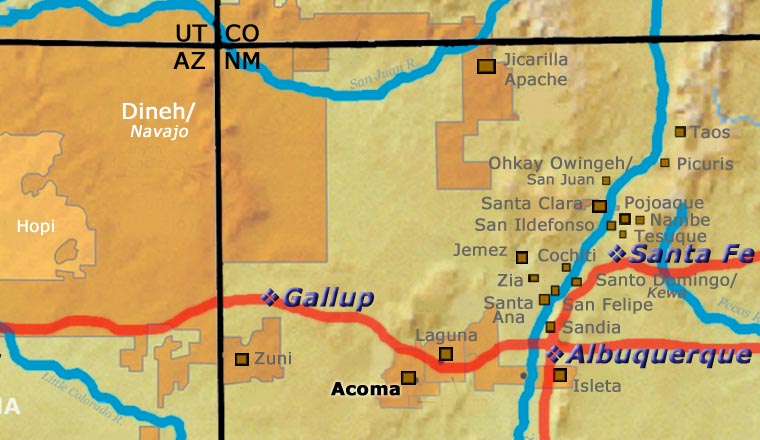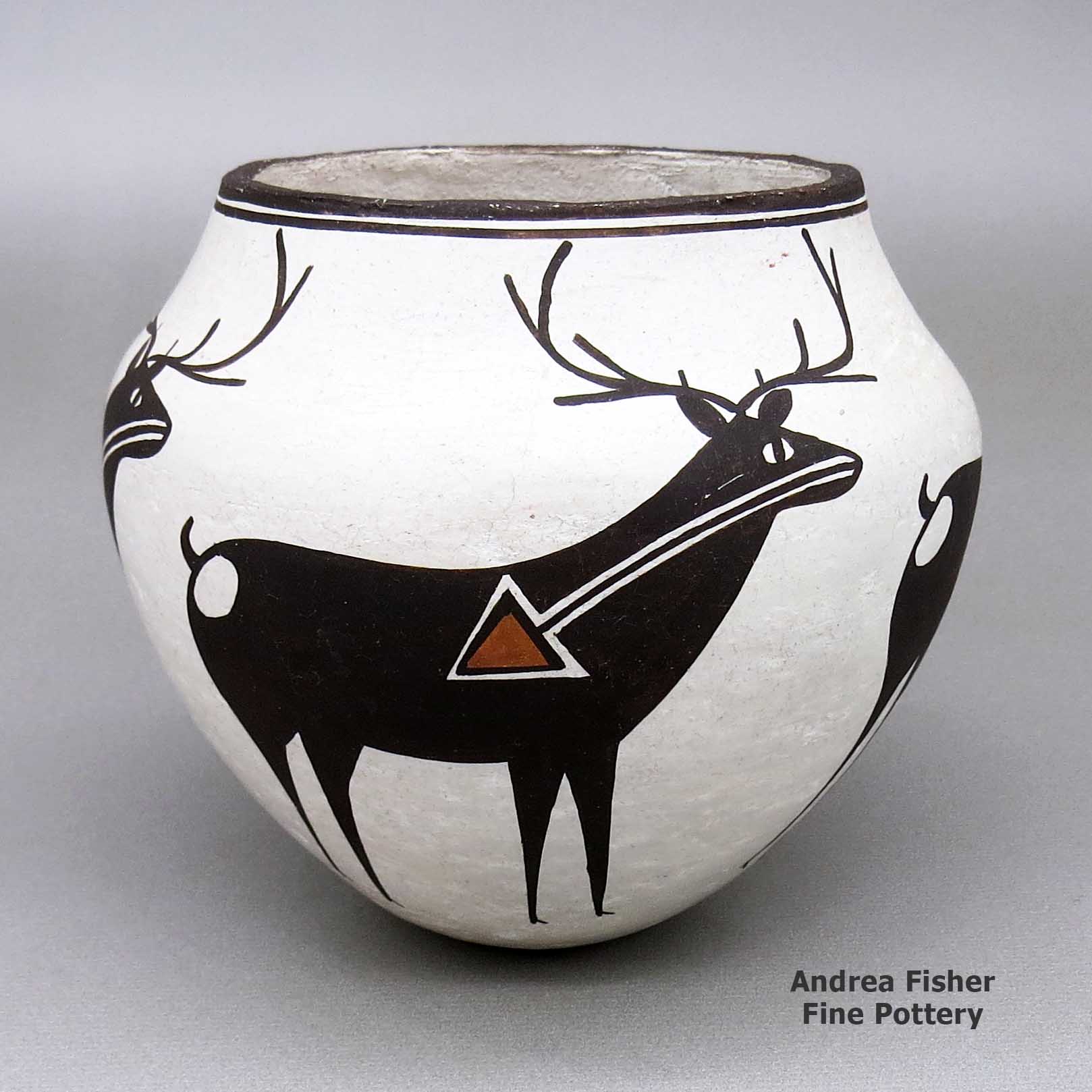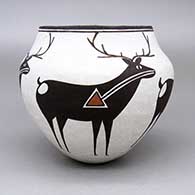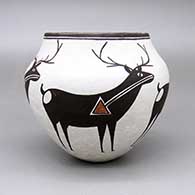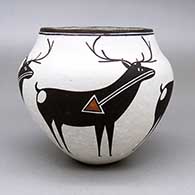
Lucy Lewis
Acoma
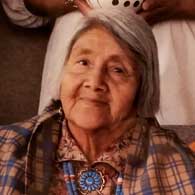
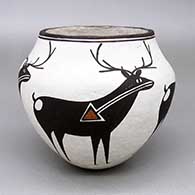
Lucy M. Lewis (1900-1992) was born and raised in Acoma Pueblo on Sky City mesa, a land formation southwest of Albuquerque that rises more than three hundred feet above the surrounding countryside.
As there were no government schools on the mesa and Lucy wasn't escorted by government agents to an off-pueblo Indian Boarding School, Lucy received no formal education beyond that which was traditional to her people, that has long been required of every Pueblo child as they grew up: she helped in the home, she learned the various steps and chants (in her native Keres tongue) necessary to participate in her people's ancient rituals and ceremonies, and she began to make pottery when she was only seven or eight years old. She learned how by watching her great-aunt Helice Vallo and other Acoma Pueblo Corn Clan women as they gathered together and made pottery the traditional way for the kiva and for their personal use.
Lucy was never exposed to off-pueblo pottery influences, her creative inspiration was derived entirely from the sherds she found as she walked around the countryside of Acoma. A large amount of what she found on the ground was decorated with Cibola, Tularosa and Mimbres-style designs. These designs were characterized generally by fine black lines forming geometric patterns, panels of geometric patterns in multiple colors, or black anthropomorphic forms, all on a white slip. From the spark lit by those sherds she developed her own methods of making and decorating pots.
In her teens, Lucy married Toribio Haskaya and together they raised nine children. She handled the household chores, helped her husband with the farming and somehow found time to squeeze in her pottery making. Due to Acoma Pueblo's remote location and the refusal of pueblo leaders to allow archaeologists, ethnographers, collectors, traders or tourists to hang around or do any excavations or business on the mesa top, Lucy was never exposed to (or interfered with by) archaeologists, museum curators, collectors, traders or tourists. She also did not travel to powwows or fairs, though she occasionally sold her pottery at the railroad station in Grants, about 20 miles from Acoma. In spite of this relative isolation, Lucy Lewis is credited with sparking the revival of Mimbres black-on-white designs.
Her pottery first became known outside the pueblo when she exhibited her wares in a juried competition in 1950. She was awarded several blue ribbons that year at the Annual Gallup InterTribal Ceremonial. That brought her to the attention of Dr. Edgar Lee Hewett, Director of the Museum of New Mexico (the same Dr. Hewett who had worked with Maria Martinez years earlier). Hewett convinced her she needed to sign her pieces and as she earned more and more blue ribbons, her signature became more and more valuable.
During the 1980s and 1990s Lucy received awards from the American Crafts Council, the College Art Association, the State of New Mexico and the Honolulu Academy of Fine Arts. She continued to make pots until she was well into her 80s. Some of her grandchildren and other descendants are still creating pottery using the methods and decorations she passed on to them.
100 West San Francisco Street, Santa Fe, New Mexico 87501
(505) 986-1234 - www.andreafisherpottery.com - All Rights Reserved

Acoma Pueblo
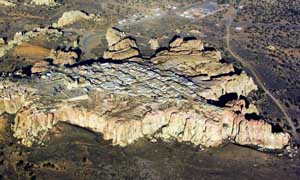
Sky City
According to Acoma oral history, the sacred twins led their ancestors to "Ako," a magical mesa composed mostly of white rock, and instructed those ancestors to make that mesa their home. Acoma Pueblo is called "Sky City" because of its position atop the mesa. Acoma is located about 60 miles west of Albuquerque.
Acoma, Old Oraibi (at Hopi) and Taos all lay claim to being the oldest continuously inhabited community in the U.S. Those competing claims are hard to settle as each village can point to archaeological remnants close by to substantiate each village's claim. While the people of Acoma have an oral tradition that says they've been living in the same area for more than 2,000 years, archaeologists feel more that the present pueblo was established near the end of the major migrations of the 1300s. The location is essentially on the boundary between the Mimbres-Mogollon and Ancestral Puebloan cultures. Each of those cultures has had an impact on the styles and designs of Acoma pottery, especially since modern potters have been getting the inspiration for many of their designs from ancient pot shards they have found while walking on pueblo lands.
Francisco Vasquez de Coronado ascended the cliff to visit Acoma in 1540. He afterward wrote that he "repented having gone up to the place." But the Spanish came back later and kept coming back. In 1598 relations between the Spanish and the Acomas took a really bad turn with the arrival of Don Juan de Oñaté and the soldiers, settlers and Franciscan monks that accompanied him. After ascending to the mesa top, Oñaté decided to force the Acomas to swear loyalty to the King of Spain and to the Pope. When the Acomas realized what the Spanish meant by that, a group of Acoma warriors attacked a group of Spanish soldiers and killed 11 of them, including one of Oñaté's nephews. Don Juan de Oñaté retaliated by attacking the pueblo, burning most of it and killing more than 600 people. Another 500 people were imprisoned by the Spanish, males between the ages of 12 and 25 were sold into slavery and 24 men over the age of 25 had their right foot amputated. Many of the women over the age of 12 were also forced into slavery and were eventually parceled out among Catholic convents in Mexico City. Two Hopi men were also captured at Acoma and, after having one hand cut off, they were released and sent home to spread the word about Spain's resolve to subjugate the inhabitants of Nuevo Mexico.
When word of the massacre and the punishments meted out got back to King Philip in Spain, he banished Don Juan de Oñaté from Nuevo Mexico. Some Acomas had escaped that fateful Spanish attack and returned to the mesa top in 1599 to begin rebuilding. In 1620 a Royal Decree was issued which established civil offices in each pueblo and Acoma had its first governor appointed. By 1680, the situation between the pueblos and the Spanish had deteriorated again to the point where the Acomas were extremely willing participants in the 1680 Pueblo Revolt.
After the successful Pueblo Revolt the Spanish retreated back to Mexico. Refugees from other pueblos began to arrive at Acoma, fearing an eventual Spanish return and reprisals. That strained the resources of Acoma until the Spanish actually did return. The residents of the pueblo had to make a hard decision. Many of the refugees chose to try a peaceful solution: they quickly relocated to the ancient Laguna area and made peace with the Spanish as soon as they appeared in the region.
Over the next 200 years, Acoma suffered from breakouts of smallpox and other European diseases to which they had no immunity. At first they sided with the Spanish against nomadic raiders from the Ute, Apache and Comanche tribes. Then New Mexico changed hands, the railroads arrived and Acoma became dependent on goods brought in from the outside world.
For many years the villagers had been content on the mesa top. Now most live in villages on the valley floor where water, electricity and other necessities are easily available. While a few families still make their permanent home on the mesa top, the old pueblo is used almost exclusively for ceremonies and celebrations these days.
It's the dense, slate-like clay, that allows Acoma pottery to be thin, lightweight and durable. After they form a pot, they paint it with a white slip. Once dry, black and red design motifs are added using mineral and plant derived paints. Fine lines, geometrics, parrots and old Mimbres designs are common motifs. The traditional paintbrush is chewed from the yucca leaf. Historically, Acoma was known for large, thin-walled "ollas," jars used for storing food and water. With the arrival of the railroad and tourists in the 1880s, Acoma potters adapted the size, shapes and styles of their pots in order to appeal to the new buyers.
Acoma potters felt it was an inappropriate display of ego to sign a pot up into the mid-1960s. Then Lucy Lewis, Jessie Garcia and Marie Z. Chino started signing their pots. The 1960s is also a time when the primary Acoma white clay vein passed through a layer of widely distributed impurities, impurities that passed through the clay filtering process and showed up only during and after the firing. The problem was so bad it affected virtually every Acoma potter and every pot they made. Thankfully, by the late 1960s they had dug through that layer of clay and into a deeper layer that didn't have the problem.
100 West San Francisco Street, Santa Fe, New Mexico 87501
(505) 986-1234 - www.andreafisherpottery.com - All Rights Reserved

Acoma
$ 1100
zzac4a279
Small polychrome jar with a four-panel deer-with-heart-line design
4.75 in L by 4.75 in W by 4.25 in H
Condition: Very good, pencil marks and rubbing on bottom, wear around rim, minor slip cracking on side, pitting, and normal wear
Signature: Lucy M. Lewis Acoma,
100 West San Francisco Street, Santa Fe, New Mexico 87501
(505) 986-1234 - www.andreafisherpottery.com - All Rights Reserved

Lucy Lewis Family Tree
Disclaimer: This "family tree" is a best effort on our part to determine who the potters are in this family and arrange them in a generational order. The general information available is questionable so we have tried to show each of these diagrams to living members of each family to get their input and approval, too. This diagram is subject to change should we get better info.
- Andrew H. Drew Lewis (1927-2005)
- Andrew H. Lewis Jr.
- Theodore Lewis
- Ann Lewis Hansen (1925-)
- Carmel Lewis Haskaya (1947-2019)
- Katarina Haskaya Lukee (1984-2015)
- Dolores Lewis Garcia (1938-)
- Emma Lewis Mitchell (1931-2013)
- Ivan Lewis (1919-2001) & Rita Lewis (Cochiti)(1920-1990)
- Mary Lewis Garcia (1933-2015)
Lucy Martin Lewis (c. 1900-1992) & Toribio Haskaya
Some of the above info is drawn from Southern Pueblo Pottery, 2000 Artist Biographies, by Gregory Schaaf, © 2002, Center for Indigenous Arts & Studies
Other info is derived from personal contacts with family members and through interminable searches of the Internet and cross-examination of the data found.
(505) 986-1234 - www.andreafisherpottery.com - All Rights Reserved


